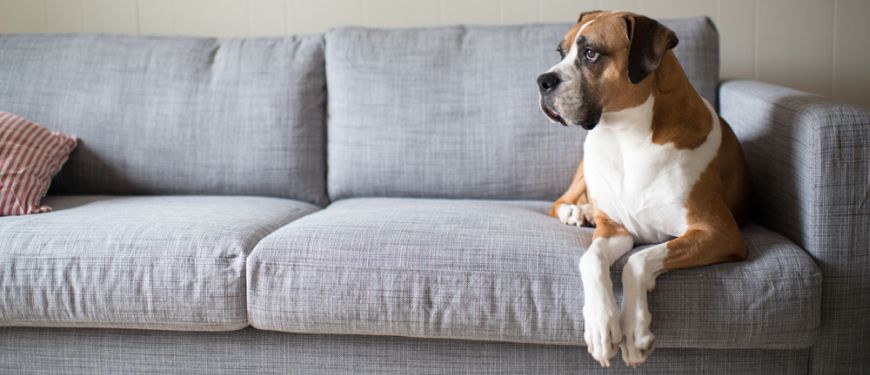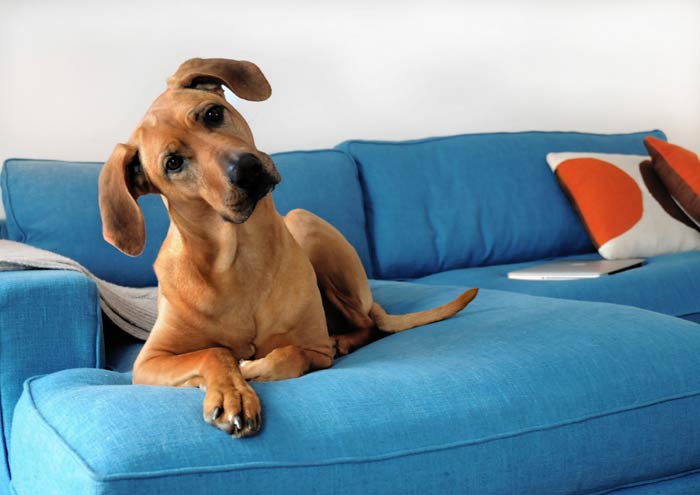According to the Pet Food Manufacturers Association’s annual report, 16 million homes across the UK had (at least) either a dog or cat as of 2016. While pets are often sources of affection and fun in our lives, they can also be difficult to live with when it comes to damaging our homes – especially where furniture is concerned. If you’re not careful, your sofa or chair can become covered in hair or claw-marks as your pets become more attached to your sofa than you’d like.
It’s important when choosing new furniture to ensure that it is as pet-friendly as possible. While all materials will eventually wear down through usage, you don’t want a new sofa to look as though it has had years of gradual deterioration in a matter of weeks because the dog enjoys sleeping on it instead of in its bed. The furniture you choose should ultimately depend on your personal preferences, but you do need to consider the effects of pets on any new piece you bring home – from scratch marks to stains brought in from the outside, there is no shortage of ways a pet can ruin sofas, chairs and upholstery in general.
There are several factors to mull over when choosing pet-friendly furniture, including material, colour and preventative extras you can invest in if you deem it necessary.
Material
The furniture fabric material will be the most important aspect to take into consideration when choosing pet-friendly furniture. Because many breeds of cats and dogs tend to shed their hair, you should be aware that certain materials will trap the hair and make it more difficult to see and remove.
Leather
While leather may not be to everyone’s tastes stylistically, it has several advantages that make it a good choice for homes with pets. It can be wiped clean, so any accidents are easily dealt with; it does not hold any odours, so pet smells won’t be embedded in the upholstery; and shed hair can be hoovered up (as long as it is visible). However, it is very susceptible to claw mark damage.
Synthetic fibres
Although manmade fibres typically don’t make good clothes, they do make good upholstery. They are extremely dirt-resistant, versatile and easy to care for. Because they are tightly woven, they won’t catch pet hair (which is then difficult to get out), and they can be wiped clean easily. Most synthetic sofas will absorb odours, however.
Chenille
Chenille is a perennially popular furniture upholstery option because of its softness and textured appearance, but it holds few advantages for those homes that also house cats and dogs. Claws and nails can be caught in the surface of the fabric and unravel the finish which is then impossible to repair.
Velvet
Velvet can sometimes be a decent option – its generally dark shades mean that stains can be easily hidden and it can be easily brushed over to remove hairs. Big stains, though, cannot easily be removed from the upholstery and it can be damaged by heavy animals lying in the same spot.
Colour
You won’t be able to constantly clean shed hair off your sofa so, for those times when you need a quick fix, consider purchasing furniture the same colour as your pet’s fur. A golden retriever’s fur will be painfully obvious on black upholstery, for example. It doesn’t have to be an exact match, not least because you may find it difficult to find a colour that will both fit in with your interior décor scheme and hide pet hair, but as a general rule, try to stick to dark shades if you have pets with dark fur and lighter shades if you have lighter-coloured pets.
Extras
Disposable covers
Some pets, especially cats tend to use a piece of furniture as a scratching post as soon as they’re brought home, which can irreparably damage them. Some fabrics, especially those which are tightly woven, can take this sort of treatment relatively durably, but it may not be worth the risk from your point of view.
With this in mind, you could invest in extra loose covers to be used until you have trained your pet not to use the chair or sofa as a scratching post. As these are much cheaper than a brand-new piece of furniture, it’s much more preferable for the pet to scratch these than the actual sofa. They can then be thrown away when they become too damaged – the number you go through will depend on how easy your pet is to train.
Stain-repellent spray
If stains are a particular worry for you in terms of cats and dogs bringing them from the garden or from walks, you can use a stain-repellent spray to protect upholstery. They are usually safe to use on all fabrics, but you should check the bottle to ensure it won’t damage your sofa instead of helping keep it safe.
Throws and blankets
As temporary coverings, throws and blankets can be a good way of protecting upholstery as long as you don’t mind them getting damaged instead of the sofa. They’ll need to be big enough to tuck into the sides and bottom of the furniture so they don’t get pulled out, but as a short-term measure they can be extremely effective.
While you should always choose a sofa that works within your living room in terms of style, colour and comfort, always remember that pets can wreck it before you’ve had a chance to enjoy it. Until they have been trained to leave it alone, you can employ temporary measures, but the material you choose should be the main factor in your decision. The durability of the upholstery, in addition to how easy it is to clean, should be top of the agenda. With the right upholstery and the right protection, you will be able to enjoy your furniture for years.







